Managing Solid Waste from Single-Use Systems in Biopharmaceutical Manufacturing
The increasing implementation of single-use systems (SUS) in biopharmaceutical manufacturing has been driven by multiple factors including cost reduction, increased flexibility, improved process development time, and reduced capital investment. But questions are being raised over the disposal of solid waste materials from this alternative technology. Disposal concerns may not be justified on financial considerations because solid-waste disposal costs represent only a small proportion of the total manufacturing costs when using disposable systems (1, 2). Furthermore, comparative studies have shown that traditional stainless steel systems incur higher costs for their cleaning and rinsing operations, which include disposal of liquid waste (3).
Perhaps a broader concern today for disposal of single-use processes is their potential environmental impact. Some studies have compared this for disposables with the energy consumption demands of stainless steel systems for sterilization, cleaning, and raw materials, concluding that the total energy consumption for single-use systems is about half that of traditional systems (4). But another concern to address is the environmental impact of currently available methods of disposal, especially in regards to increasing controls and legislation being introduced to protect the environment and ensure long-term industrial sustainability.
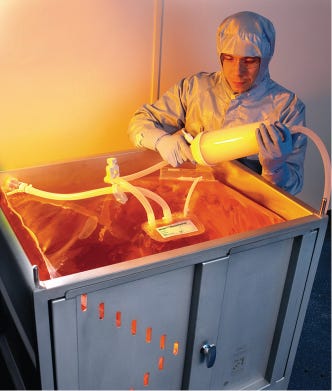
Figure 1:
PALL LIFE SCIENCES (WWW.PALL.COM)
Here we summarize the methods available for management of solid waste and provide working examples of disposal options for many single-use components. By offering such information, suppliers of components and systems can help users manage waste from disposable systems and also help them establish a responsible approach in their own environmental management programs. We strongly encourage readers to contact waste-management specialists within their own companies to develop their understanding of how plastic waste from other sources (e.g., packaging and labware) is currently handled at their facilities.
Solid-Waste Disposal Options for Disposable Systems
Other publications have detailed the disposal routes available for solid organic waste. Guidelines from the Bio Process Systems Alliance (BPSA) provide a very useful summary (5). We offer a short review to provide our basis for a waste management selection procedure.
The disposal methods can be divided into three major groups: recycling options (reuse of components, reprocessing of recycled material, and production of liquid fuel by pyrolysis); incineration (with or without energy recovery); and landfills (nonhazardous waste, hazardous waste, and landfill methane use in energy production). To identify a preferred disposal method for a given component or system, it can be beneficial to draw up a simple checklist derived from a few basic questions, as listed in the “Checklist” box.
Answering those questions may form part of a risk assessment and ultimately lead to a decision regarding the preferred method. Local factors not listed will inevitably play a major role in each decision process as well. Today one of the most important considerations in reviewing disposal methods is their impact on the environment. Ideally, the method with the lowest impact would be selected. For this reason, we list the options in order of general user preference.
Recycling
Reuse of Components: In principle, component reuse is the most environmentally friendly option. In practice, however, it is probably the most difficult to apply to single-use components in biomanufacturing. This dilemma arises because reuse of such components conflicts with many of their technological benefits. It may be possible to consider reusing some items such as flexible containers, tubing, and filters used for processing and storing simple solutions (e.g., nonsterile buffers that don’t support microbial growth). In some processes, such reuse is standard practice. Similarly, compressed air or venting capsule filters are often used for many batches or for extended periods before disposal. If components are reused, a risk assessment during process qualification and validation would be essential and appropriate standard operating procedures (SOPs) must be written.
For sterilized components, the requirements of cleaning and resterilization before reuse are critical. Functionality of a product may also determine its suitability for single or multiple uses. For example, sterile connectors with removable protective barriers or irreversible locking mechanisms are not reusable. Many components that come into direct contact with a product will be considered unsuitable for reuse once a risk assessment has been performed. Restrictions on reuse of those that do not contact process fluids (e.g., plastic pallets, packaging) may be much more lenient, and their reuse could be a very desirable procedure environmentally as well as provide potential cost savings.
Reprocessing of Recycled Materials: For plastic materials, reprocessing depends on two key requirements:
Waste should contain only a single polymer type
Quantities must be sufficient to make recycling commercially viable.
Recycling of plastics (and other materials such as paper, glass, and steel) by reprocessing is now widely used for domestic and much industrial waste. When this approach is considered for single-use plastic components in biomanufacturing, some single polymer components such as all-polypropylene filter capsules and thermoplastic tubing can be considered suitable. The main constraints are the presence of contaminating or hazardous substances, polymers unlisted in the major resin recycling code groups (6), and items inseparably joined to dissimilar component(s) in a system.
It may be possible to recycle even heterogeneous components by separating materials after use (e.g., cutting off a sensor or vent assembly or silicone tubing from a large recyclable plastic component). But some components may contain several different, inseparable materials of construction that make them unsuitable for reprocessing.
A good understanding of the recycling potential of components and systems at the early stages of process development could help ensure the maximum possible recyclability of waste and to minimize environmental impact. To assist in such assessments, information on materials of construction and recyclability may be available in some suppliers’ material data safety sheets (MSDSs) or other product information. Manufacturers of components are also investigating ways of enhancing the recycling potential of their products provided that such enhancements do not compromise their functionality and safety.
Another important consideration for component or system suppliers relates to recycling of electronic and electrical equipment associated with process systems. Although such items would be more typically associated with traditional stainless steel systems, the use of electronic sensors, controls, and other electrical attachments is increasing in single-use systems and offering significant benefits for process control. Regulations on disposal of such items are becoming increasingly severe. For example, if suppliers wish to sell certain categories of electrical components within a process system into European Community (EC) member states, those products must comply with the EU Directive on Waste Electrical and Electronic Equipment (7). It aims to reduce the amount of electrical waste sent for disposal to landfills and incineration plants by requiring suppliers to arrange collection and recycling of the electrical components themselves.
CHECKLIST QUESTIONS FOR DECISION-MAKING
□ Does a given component have biohazardous or chemically hazardous content?
□ If hazardous, does that restrict the methods for disposal?
□ How is waste material to be handled, contained, and transported to disposal facilities?
□ Does a given disposal method involve potentially harmful gaseous emissions (e.g., dioxins, methane, or carbon dioxide)?
□ Could waste material potentially contaminate the land or water?
□ Which disposal methods are locally available?
□ Does the quantity of waste justify a given disposal method?
□ Are there local restrictions on the use of a specific method?
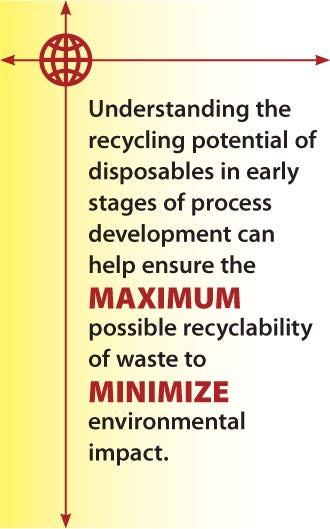
Production of Liquid Fuel By Pyrolysis: Reprocessing of plastic waste to produce fuel is a relatively new but potentially important technology. The conversion process uses pyrolysis, a method based on controlled heating of the waste at around 4,000 °C in the absence of oxygen. The catalytic breakdown of polymers into smaller molecules followed by a refining process produces a fuel comparable to regular diesel fuel but with cleaner burning properties. The typical conversion rate is approximately one liter of fuel produced per kilogram of plastic waste. Although related capital investment costs are high, pyrolysis provides a method with improved environmental benefits over both incineration and landfill options.
Incineration
Incineration without Energy Recovery: The combustion of waste is a well-established and accepted process in many locales, and it offers advantages and disadvantages listed in the “Concerning Incineration” box.
Opinions are mixed regarding the value of incineration. Some see it as a much better and preferred option to alternatives such as landfills, whereas others view it as an environmental hazard emitting a variety of particulate and gaseous pollutants into the atmosphere. The latter view may well have some basis for some earlier incinerator designs, but many of those have either been upgraded or replaced by improved designs that make atmospheric emissions perhaps less of a real problem than is commonly believed to be the case. Modern incineration processes are typically run continuously rather than batchwise, and parameters such as combustion temperatures and emissions can be carefully monitored and controlled to provide very clean emissions that meet the very latest regulations (8, 9). In addition, technology is now available for carbon dioxide capture from gaseous emissions that can help reduce the carbon footprint and environmental impact of disposable systems.
The residual incombustible debris and ash from incineration, although relatively small in volume, also requires safe disposal. Landfill is the assumed method, and risk assessment of this disposal step is required as well. In some cases, the environmental impact of incineration can be reduced by using that ash for construction materials in, for example, road building and other similar applications.
CONCERNING INCINERATION
Advantages
Available in many locations
Moderately low operating costs
Can eliminate or reduce toxicity of hazardous waste
Reduces waste to a very small percentage of its original volume
Can provide energy recovery by cogeneration
Disadvantages
Potential release of particulate and gaseous pollutants
Risk of toxic emissions
High carbon dioxide emissions
High investment costs for new facilities to meet latest emission controls and regulations
Energy Recovery from Incineration: Recent advances in incinerator technology provide an additional feature that offers strong environmental benefits, namely heat and energy recovery typically in the form of steam, hot water, or electricity. Described as cogeneration, waste-to-energy (WTE) or combined heat and power (CHP), this incorporates the benefits of modern incineration technology with an added bonus of energy recovery. The heat value of about 40,000 kJ per kilogram of mixed plastics is slightly higher than coal, which makes plastic waste from single-use bioprocess systems highly suitable for cogeneration, producing only small quantities of ash. The financial benefits of cogeneration improve with increasing throughput, resulting in larger plants that are fewer in number. This may limit the availability of local cogeneration plants, however, and make financial justification of the method more difficult for some biomanufacturing waste when transport costs are taken into consideration.
Landfill
The simplest and longest established disposal method, landfill sequestration is still widely used due to its low operating costs, availability in most locations, and suitability for most solid wastes. However, landfill is coming under increasing public pressure due to various constraints including a shortage of landfill sites; the high bulk volumes of untreated wastes; local opposition to landfills based on their noise, odors, appearance, and so on; and financial levies and/or legislative restrictions on landfill (10). Despite these constraints, landfills are likely to remain an available option in many countries for single-use/disposable components until acceptable alternatives are fully developed. Landfill waste can be handled in various ways.
Nonhazardous Waste: Single-use system waste that presents no bio- or chemical hazard is often sent untreated directly to landfill. Typical such materials would be filters, bags, and tubing used for simple solutions such as buffers, water, and so on. The volume of this nonhazardous waste can be reduced by compaction in high pressure presses or by grinding or shredding. Although such steps may incur additional investment and operating costs, they can improve subsequent handling and may also help to reduce landfill costs if those are volume dependent. Volume reduction also may be achieved through heat treatment with steam or dry heat, a procedure that can also have other benefits described below.
Hazardous Waste: If waste material represents a biohazard — for example, containing an infectious organism or a potent biopharmaceutical agent — then autoclaving will usually inactivate or neutralize the contaminants before disposal. Commonly used in hospitals, such a procedure may also be followed by compaction or grinding to reduce volume. Some users take a more general approach by regarding all solid waste from single-use processes as potentially hazardous and simply autoclaving everything. This may have the benefit of qualifying all material as safe for disposal in local municipal landfill sites.
When a biohazard is resistant to autoclave steam temperatures, then heat treatment at higher temperatures may be possible. Alternatively, gamma irradiation at appropriate dose levels may be preferred especially if an irradiation facility is conveniently available. In some cases, chemical treatment (e.g., chlorine dioxide) can be used as an effective decontaminant procedure before sending waste to a landfill (11). If no pretreatments are suitable, then alternative disposal methods (e.g. incineration or specialized disposal) may have to be considered.
Chemically hazardous waste may be a problem in some processes that involve, for example, strong acids or bases used for pH control of fluids in bioreactors or compounding vessels. Some form of specific neutralization may be possible before sending waste to a landfill. If not, alternative disposal methods that inactivate chemical hazards (e.g., incineration) or shipment to specialized chemical waste specialists will be required.
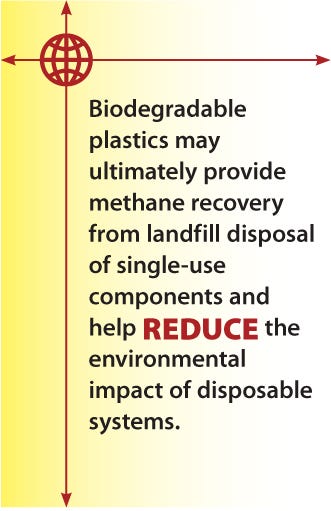
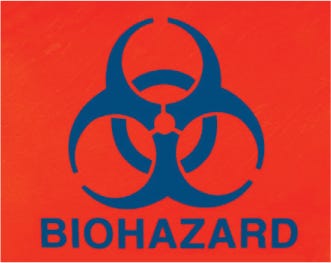
CHRIS DE RAUD (WWW.ISTOCKPHOTO.COM)
Landfill Methane: Natural anaerobic fermentation of landfill biomass, especially domestic organic waste, will produce off-gases, of which approximately half is methane. This methane can be considered either as a disadvantage or a benefit, as described in the “Considering Methane” sidebar. The trend toward biodegradable plastics may ultimately provide methane recovery from landfill disposal of single-use components and help reduce the environmental impact of disposable systems.
Selection Process
In many biopharmaceutical manufacturing plants, waste disposal procedures may be well established for other plastics, with specialists available to discuss the best possible routes for waste management of single-use systems. External waste management companies and consultants also can provide guidance on disposal methods. If such advice on waste disposal is not easily available, then selection procedure of the most suitable methods for a specific process can be complex and difficult, especially for multicomponent systems. The decision tree for waste management of single-use components in Figure 1 is meant to assist in such decisions.
CONSIDERING METHANE OFF-GAS
Disadvantages
Methane is a flammable gas creating a potentially explosive landfill environment if it is not controlled. And released methane has 23 times higher global warming potential than carbon dioxide released during incineration.
Advantages
Methane capture is now a standard procedure from landfill sites, not only to control explosion risks but also to provide energy from its combustion. In principle, industrial waste from disposable systems could contribute to this energy recovery process. However, most single-use components are made from plastics that contain insignificant amounts of biodegradable material for anaerobic fermentation.
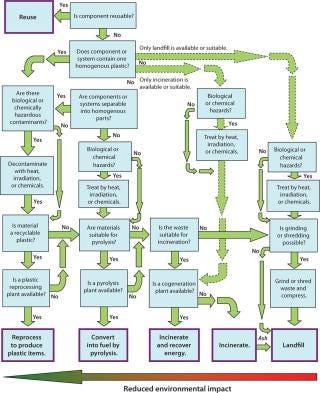
Figure 1: ()
In addition to providing a structured form of checklist, the decision tree aims to highlight the more environmentally favorable options for various waste materials. The extreme left side leads to reuse or reprocessing of waste, the most beneficial options for the environment and sustainability. And the far right side of the tree leads to either landfill of uncompressed waste or incineration without energy recovery, arguably the least favorable methods in terms of environmental impact.
Seeking a Responsible Approach
Management of solid waste and protection of the environment cannot be ignored when introducing single-use systems into biomanufacturing processes. Although in many situations current practices for other processes may be applicable, stricter legislation together with enhanced technologies for waste disposal methods may require a review of waste management procedures. Such reviews can often lead to financial benefits for biopharmaceutical companies, but the primary objective is continuous improvement regarding environmental impact and a responsible approach to environmental management.
REFERENCES
1.) Sinclair, A, and M. Monge. 2004. Concept Facility Based on Single-Use Systems, Part 1. BioProcess Int. 2:26-31.
2.) Sinclair, A, and M. Monge. 2005. Concept Facility Based on Single-Use Systems, Part 2. BioProcess Int. 3:S51-S55.
3.) Fuller, M, and H. Pora. 2008. Introducing Disposable Systems into Biomanufacturing: A CMO Case Study. BioProcess Int. 6:30-36.
4.) Rawlings, B, and H. Pora Environmental Impact of Single-Use and Reusable Bioprocess Systems. BioProcess International.
5.) Wells, B. 2007. Guide to Disposal of Single-Use Bioprocess Systems. BioProcess Int. 6:S24-S27.
6.) Resin Identification Codes, American Chemistry Council, Arlington.
7.) Directive on Waste Electrical and Electronic Equipment (WEEE)European Commission.
8.) 2000. Directive 2000/76/EC of the European Parliament and of the Council of 4 December 2000 on the Incineration of Waste. Off. J. European Communities http://ee.europa.eu/environment/wasteinc/newdir/2000-76_en.pdf.
9.) Guide for Industrial Waste Management, US Environmental Protection Agency, Washington.
10.) European Union.
11.) Wintner, B. 2006. Deactivation of Single-Use Bioprocessing Systems Using Aqueous Chlorine Dioxide. BioProcess Int. 4:S52-S56.
You May Also Like





